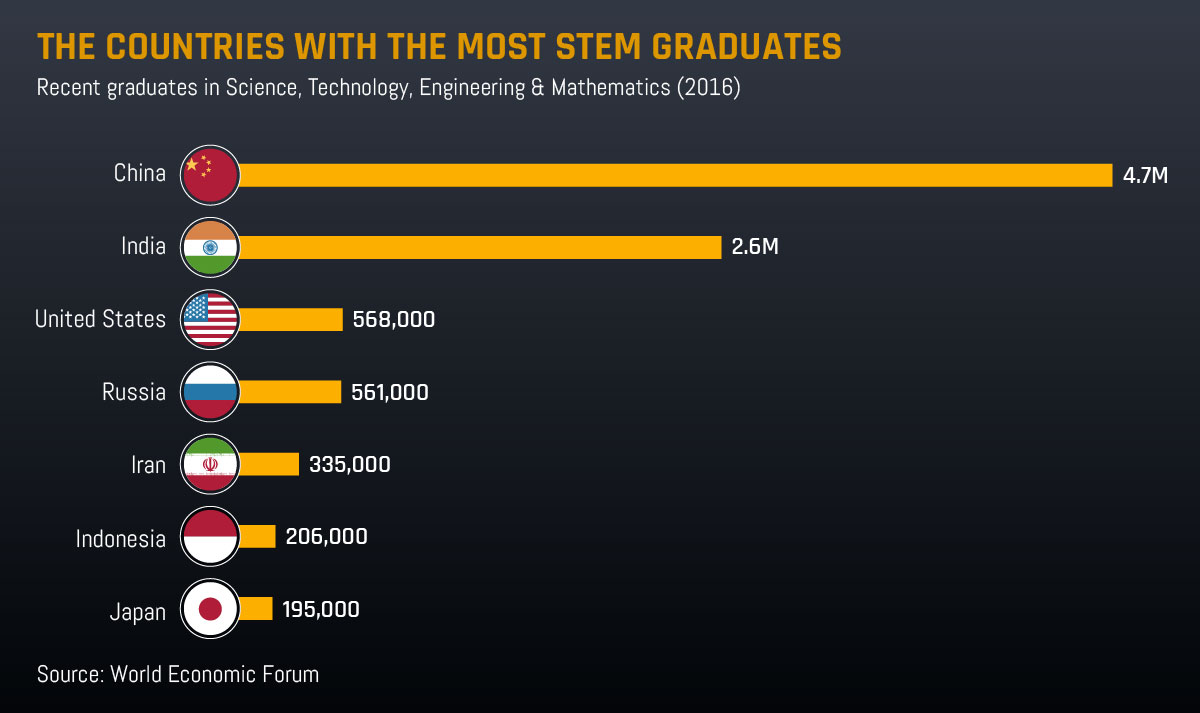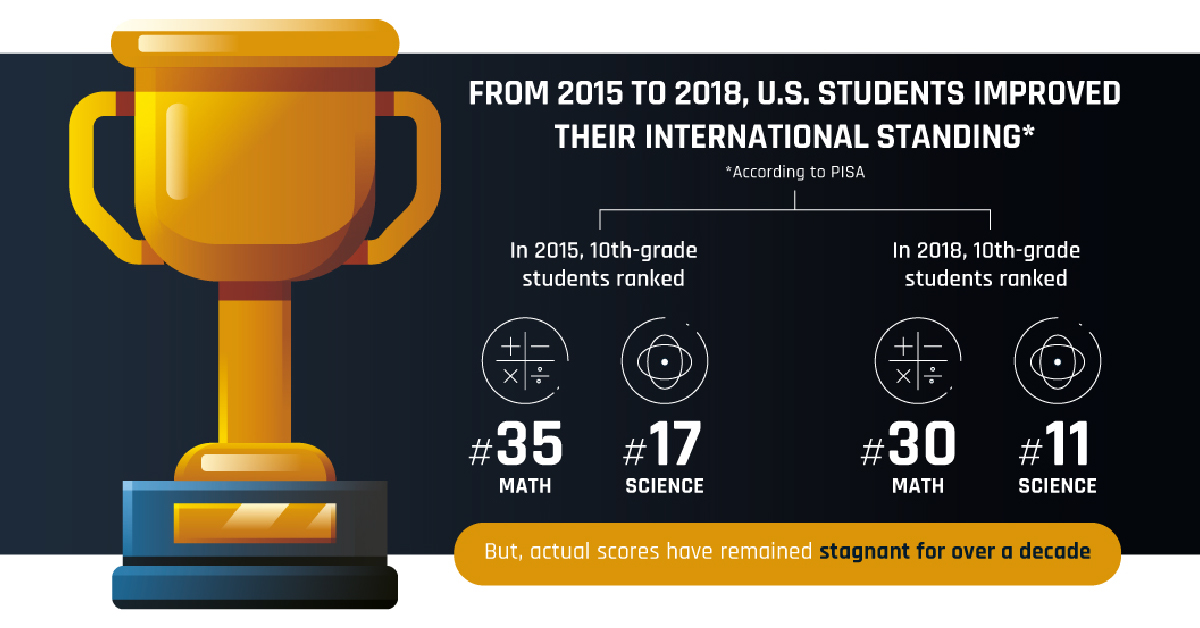Technology
How the STEM Crisis is Threatening the Future of Work
<img src="https://www.visualcapitalist.com/wp-content/uploads/2020/01/STEM-1200.jpg" alt="STEM education infographic"
How the STEM Crisis Threatens the Future of Work
As the world’s leading economy, the U.S. is under pressure to produce the best minds to solve the greatest challenges facing mankind.
The problem is, the United States is falling behind in some of the most important areas of education to help solve the problems of today and tomorrow. The crisis in STEM fields—which cover science, technology, engineering and mathematics—is threatening the growing workforce and in turn, the country’s position in the global economy.
Today’s infographic from Early Childhood Education Degrees explores the importance of STEM education and how an emphasis on these four areas could successfully lead the world into an uncertain future.
The Rise of STEM
STEM is a relatively new term, coined less than two decades ago—although the grouping of subjects was sometimes referred to as SMET in previous years.
While 86% of Americans believe that increasing the number of workers in STEM areas is vital for maintaining their position in the global economy, a 2005 report sounded the alarm that U.S. students were lagging behind academically.
To combat this issue, STEM education and subsequent research programs were injected with more funding. New legislation also helped prioritize these subjects in the curriculum for kindergarten through high school.
The Skills Shift
According to Emsi, a modeler of economic data, undergraduates in STEM education increased by 43% between 2010 and 2016. However, despite the promising growth, 2.4 million STEM jobs went unfilled in 2018.
One possible reason for this? Advancing technologies such as artificial intelligence, quantum computing, and robotics require entirely new skill sets. Success in STEM jobs also relies on adapting to new situations and developing soft skills such as:
- Creativity and innovation
- Problem-solving and critical thinking
- Collaboration and leadership
As these technologies continue to evolve, having skills in STEM will be non-negotiable for employees and leaders the world over.
Threatening U.S. Economic Leadership
Statistics show that the U.S. is providing more opportunities for other countries to take the lead in STEM fields. For example, 62% of all international students in tertiary education in the U.S. are in science and engineering fields, with almost 70% of those students coming from India and China.
What’s more, over half of all U.S. patents go to foreign nationals and companies instead of Americans at home.
If America’s STEM proficiency continues to decline, not only will the skills gap be detrimental to the workforce, but it will also erode its potential future for economic and scientific leadership.
The Global STEM Leaders
According to the World Economic Forum, China is a major player in STEM education, boasting 4.7 million graduates as of 2016.
The country’s swift uptake of STEM initiatives is driven by new government policy, school participation, and parents’ increasing awareness of the benefits that will future proof the careers of their children.

The U.S. sits in third place with 568,000 STEM graduates, but compares closely with India on STEM graduates per population—1 to 52 in India and 1 to 57 in the United States. However, they’re still no match for China’s 1 to 29 ratio.
Narrowing the Skills Gap
If the U.S. is to become a global leader in STEM literacy, innovation, and employment, the Department of Education suggests that a STEM reform is needed, with the increase of diversity and inclusion being a top priority.
A significant opportunity for growth lies in making STEM more accessible for women—but while there has been a steady rise in women pursuing STEM careers, there are still systemic barriers in place that prohibit women from entering.
Experts also suggest that the introduction of STEM at an earlier age and educating students on the diversity of STEM careers are crucial elements in preparing a more capable workforce.
Given the recent demand for reform, it is clear that STEM education is key to thriving in the new technology-based economy and cultivating solutions to real world problems.
Brands
How Tech Logos Have Evolved Over Time
From complete overhauls to more subtle tweaks, these tech logos have had quite a journey. Featuring: Google, Apple, and more.

How Tech Logos Have Evolved Over Time
This was originally posted on our Voronoi app. Download the app for free on iOS or Android and discover incredible data-driven charts from a variety of trusted sources.
One would be hard-pressed to find a company that has never changed its logo. Granted, some brands—like Rolex, IBM, and Coca-Cola—tend to just have more minimalistic updates. But other companies undergo an entire identity change, thus necessitating a full overhaul.
In this graphic, we visualized the evolution of prominent tech companies’ logos over time. All of these brands ranked highly in a Q1 2024 YouGov study of America’s most famous tech brands. The logo changes are sourced from 1000logos.net.
How Many Times Has Google Changed Its Logo?
Google and Facebook share a 98% fame rating according to YouGov. But while Facebook’s rise was captured in The Social Network (2010), Google’s history tends to be a little less lionized in popular culture.
For example, Google was initially called “Backrub” because it analyzed “back links” to understand how important a website was. Since its founding, Google has undergone eight logo changes, finally settling on its current one in 2015.
| Company | Number of Logo Changes |
|---|---|
| 8 | |
| HP | 8 |
| Amazon | 6 |
| Microsoft | 6 |
| Samsung | 6 |
| Apple | 5* |
Note: *Includes color changes. Source: 1000Logos.net
Another fun origin story is Microsoft, which started off as Traf-O-Data, a traffic counter reading company that generated reports for traffic engineers. By 1975, the company was renamed. But it wasn’t until 2012 that Microsoft put the iconic Windows logo—still the most popular desktop operating system—alongside its name.
And then there’s Samsung, which started as a grocery trading store in 1938. Its pivot to electronics started in the 1970s with black and white television sets. For 55 years, the company kept some form of stars from its first logo, until 1993, when the iconic encircled blue Samsung logo debuted.
Finally, Apple’s first logo in 1976 featured Isaac Newton reading under a tree—moments before an apple fell on his head. Two years later, the iconic bitten apple logo would be designed at Steve Jobs’ behest, and it would take another two decades for it to go monochrome.
-

 Green1 week ago
Green1 week agoRanked: The Countries With the Most Air Pollution in 2023
-

 Automotive2 weeks ago
Automotive2 weeks agoAlmost Every EV Stock is Down After Q1 2024
-

 AI2 weeks ago
AI2 weeks agoThe Stock Performance of U.S. Chipmakers So Far in 2024
-

 Markets2 weeks ago
Markets2 weeks agoCharted: Big Four Market Share by S&P 500 Audits
-

 Real Estate2 weeks ago
Real Estate2 weeks agoRanked: The Most Valuable Housing Markets in America
-

 Money2 weeks ago
Money2 weeks agoWhich States Have the Highest Minimum Wage in America?
-

 AI2 weeks ago
AI2 weeks agoRanked: Semiconductor Companies by Industry Revenue Share
-

 Travel2 weeks ago
Travel2 weeks agoRanked: The World’s Top Flight Routes, by Revenue















